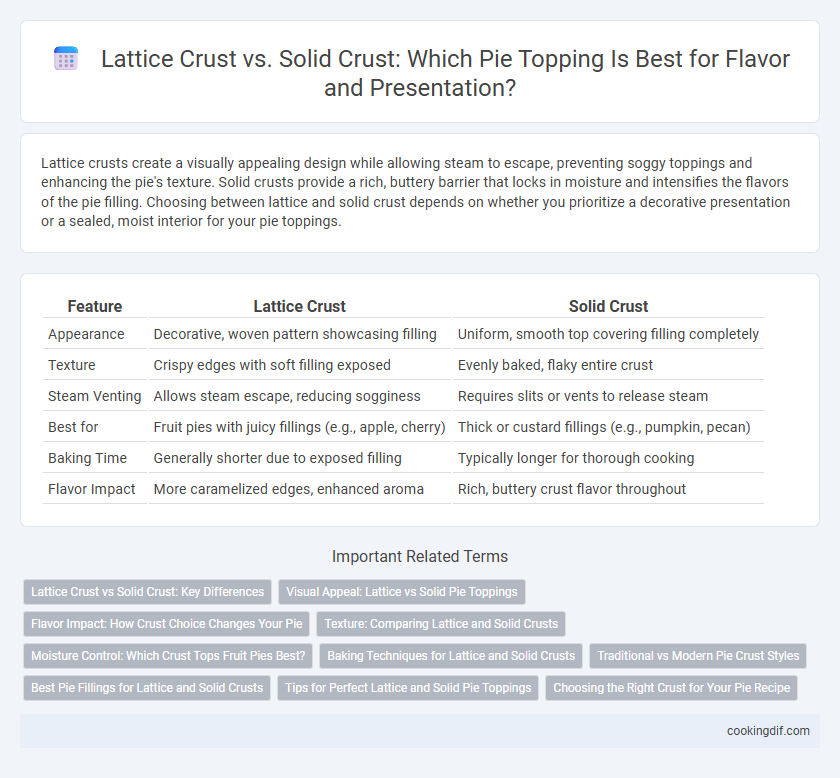Lattice crusts create a visually appealing design while allowing steam to escape, preventing soggy toppings and enhancing the pie's texture. Solid crusts provide a rich, buttery barrier that locks in moisture and intensifies the flavors of the pie filling. Choosing between lattice and solid crust depends on whether you prioritize a decorative presentation or a sealed, moist interior for your pie toppings.
Table of Comparison
| Feature | Lattice Crust | Solid Crust |
|---|---|---|
| Appearance | Decorative, woven pattern showcasing filling | Uniform, smooth top covering filling completely |
| Texture | Crispy edges with soft filling exposed | Evenly baked, flaky entire crust |
| Steam Venting | Allows steam escape, reducing sogginess | Requires slits or vents to release steam |
| Best for | Fruit pies with juicy fillings (e.g., apple, cherry) | Thick or custard fillings (e.g., pumpkin, pecan) |
| Baking Time | Generally shorter due to exposed filling | Typically longer for thorough cooking |
| Flavor Impact | More caramelized edges, enhanced aroma | Rich, buttery crust flavor throughout |
Lattice Crust vs Solid Crust: Key Differences
Lattice crusts create an intricate pattern of woven dough strips, allowing steam to escape and enhancing the pie's visual appeal with a golden, crispy texture. Solid crusts provide a sealed top, preserving moisture and juices within the pie, resulting in a softer, more tender topping that locks in flavors. Choosing between lattice and solid crusts depends on the desired balance of texture, moisture retention, and aesthetic presentation in fruit pies such as apple or cherry.
Visual Appeal: Lattice vs Solid Pie Toppings
Lattice crusts create an intricate, woven pattern that showcases the vibrant colors and textures of pie fillings, enhancing the visual appeal and inviting a rustic, homemade charm. Solid crusts offer a smooth, uniform surface that can be decorated with cutouts or brushed with egg wash for a golden, glossy finish, presenting a classic and polished look. Choosing between lattice and solid crusts depends on whether the goal is to highlight the filling with transparency or provide a sleek, traditional appearance.
Flavor Impact: How Crust Choice Changes Your Pie
Lattice crust allows steam to escape during baking, preserving the brightness of fruit toppings and enhancing their natural sweetness with a slightly caramelized flavor. Solid crust traps moisture, creating a more intensely flavored filling as juices meld but can result in a softer, less crisp texture on top. Choosing between lattice and solid crust directly impacts the pie's overall flavor profile and textural contrast, affecting the balance between the crust's buttery richness and the filling's freshness or depth.
Texture: Comparing Lattice and Solid Crusts
Lattice crusts offer a crisp, flaky texture with distinct, airy gaps that allow fruit fillings to bubble and caramelize, enhancing both flavor and presentation. Solid crusts provide a denser, buttery bite that creates a sealed environment, retaining moisture and producing a tender, rich topping. Texture preference often depends on whether a lighter or more uniform mouthfeel is desired in the pie experience.
Moisture Control: Which Crust Tops Fruit Pies Best?
Lattice crusts excel at moisture control for fruit pies because their open weave allows steam to escape, preventing sogginess and maintaining a crisp texture. Solid crusts trap more steam, often leading to a softer, sometimes soggy bottom layer especially with high-moisture fillings like berries or peaches. For optimal moisture management and a perfectly textured pie top, lattice crusts are ideal.
Baking Techniques for Lattice and Solid Crusts
Lattice crusts require careful weaving of dough strips to create an even pattern that allows steam to escape, preventing sogginess and ensuring a crisp finish. Solid crusts demand venting slits or decorative piercings to release steam and avoid bubbling or cracking during baking. Both techniques benefit from brushing with egg wash for a golden-brown and glossy texture, enhancing the visual appeal and flavor of the pie.
Traditional vs Modern Pie Crust Styles
Lattice crusts, a hallmark of traditional pie baking, offer a visually appealing, open weave that allows steam to escape and fruit fillings to thicken evenly, enhancing texture and flavor. Solid crusts, favored in modern pie styles, provide a fully sealed top that locks in moisture and juiciness, ideal for custard or cream pies requiring a smooth, uniform surface. Both crusts serve unique functional and aesthetic purposes, reflecting the evolution from rustic, handmade artistry to contemporary, precise baking techniques.
Best Pie Fillings for Lattice and Solid Crusts
Lattice crusts are ideal for fruit fillings like apple, cherry, and berry mixes, as they allow steam to escape and highlight the vibrant colors and textures of the fruit. Solid crusts suit rich, custard-based fillings such as pumpkin, pecan, and sweet potato, providing a sturdy, enclosed barrier that retains moisture and enhances the creamy consistency. Choosing the right crust complements the filling's characteristics, ensuring optimal baking results and flavor balance.
Tips for Perfect Lattice and Solid Pie Toppings
Achieve a perfect lattice crust by using chilled dough strips to maintain shape and weaving them evenly for optimal browning and ventilation, which prevents soggy fillings. For a solid crust, dock the dough with a fork or vent slits to release steam and avoid bubbles, while brushing with egg wash ensures a glossy, golden finish. Both crust types benefit from pre-chilling and evenly rolling dough to create a flaky, tender texture that complements any pie filling.
Choosing the Right Crust for Your Pie Recipe
Lattice crust offers a visually appealing design that allows steam to escape, ideal for fruit pies needing thickening and a balance of textures. Solid crust provides a sturdy, sealed top that locks in moisture, perfect for custard or cream pies requiring a smooth, uniform finish. Selecting the right crust depends on the filling's moisture content and the desired presentation, ensuring optimal taste and pie structure.
Lattice crust vs solid crust for pie toppings Infographic

 cookingdif.com
cookingdif.com